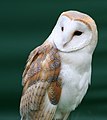| Carnus hemapterus | |
|---|---|

| |
| Scientific classification | |
| Domain: | Eukaryota |
| Kingdom: | Animalia |
| Phylum: | Arthropoda |
| Class: | Insecta |
| Order: | Diptera |
| Family: | Carnidae |
| Genus: | Carnus |
| Species: | C. hemapterus
|
| Binomial name | |
| Carnus hemapterus | |
| Synonyms | |
Carnus hemapterus is a Dipteran insect, a small-bodied and partly black-coloured carnid fly. In their adult stage of life, they are blood-sucking ectoparasites of nestling birds. Within the genus Carnus, this is the only species widespread across Europe and the cold and temperate regions of Asia and North America. Female body length is about 1.5 mm, males are smaller. It typically occurs in the nests of medium- to large-bodied birds, provided that the nest is not on the ground. It is particularly common on the chicks of owls, falcons, rollers, bee-eaters and starlings. Females give birth to larvae that live within the nest and feed on organic debris and the pupae also overwinter there. The emergence of imagines is synchronized to the hatch of host nestlings in the subsequent year. They prefer larger chicks within the nest.[6] Adult flies have a winged and an unwinged variety, the latter being more common. In fact, unwinged flies still carry the basal part of their wings, but the majority of the wing is broken off (see a close view of the above photo). Flies live only on the nestlings before and during the development of the plumage, and disappear later on.[7][8]
Infestations by Carnus hemapterus appear to be rather harmless for the host chicks. In spite of that, barn owl females advertise their resistance genes by the dark spots on their breast and belly;[9] nestlings of heavily spotted females tend to be more resistant. In this study, potential environmental confounding effects were controlled for by cross-fostering chicks.
The faeces and blood remains from these ectoparasitic flies make spots on the eggshell surface of host birds. This contamination appear to increase abundance and diversity of eggshell bacterial loads and, consequently, increase the chance of embryo death.[10][11]
-
Barn owl, heavily spotted
-
Barn owl, medium coloration
-
Barn owl, weakly spotted
- ^ Nitzsch, C.L. (1818). "Die Familien und Gattungen der Thierinsekten (Insecta epizoica) als Prodromus einer Naturgeschichte derselben" (PDF). Mag. Ent. (Germar). 3: 261–316. Retrieved 19 January 2022.
- ^ Schiner, I. R. . (1863). "Vorlaufiger Commentar zum dipterologischen Theile der "Fauna Austriaca", mit einer naheren Begrundung der in derselben aufgenommenen neuen Dipteren-Gattungen. V. [concl]". Wien. Ent. Monstschr. 7: 217–226. Retrieved 17 June 2018.
- ^ Stobbe, R. (1913). "Zur Kenntnis der Gattung Carnus Nitzsch (= Cenchridobia Schiner) mit 1 nov. sp. (Dipt.)" (PDF). Deutsche entomologische Zeitschrift. 1913: 192–194. Retrieved 20 January 2022.
- ^ Newman, E. (1834). "Attempted division of British insects into natural orders". The Entomological Magazine. 2: 379–431. Retrieved 10 November 2021.
- ^ Brake, I (2011). "World Catalog of the Family Carnidae (Diptera, Schizophora)" (PDF). MYIA. Retrieved 4 January 2013.
- ^ F. Valera; H. Hoi; A. Darolova; J. Kristofik (2004). "Size versus health as a cue for host a test of the tasty chick hypothesis" (PDF). Parasitology. 129 (1): 59–68. doi:10.1017/S0031182004005232. PMID 15267112. S2CID 18781148. Archived from the original (PDF) on 2007-02-21.
- ^ F. Valera; A. Casas-Criville; M. A. Calero-Torralbo (2006). "Prolonged diapause in the ectoparasite Carnus hemapterus (Diptera: Cyclorrhapha, Acalyptratae) — how frequent is it in parasites?" (PDF). Parasitology. 133 (Pt 2): 179–186. doi:10.1017/S0031182006009899. PMID 16623966. S2CID 2233395. Archived from the original (PDF) on 2007-02-21.
- ^ Petrescu, A; Adam, C (2000). "Carnus Hemapterus Nitzsch, 1818 (Diptera: Carnidae) Parasite On Merops Apiaster L. (Aves: Meropidae) In Southern Romania" (PDF). Travaux du Muséum National d'Histoire Naturelle "Grigore Antipa". 42: 221–224. ISSN 2247-0735. Retrieved 4 January 2013.[permanent dead link]
- ^ A. Roulin; C. Riols; C. Dijkstra; A.-L. Ducrest (2001). "Female plumage spottiness signals parasite resistance in the barn owl (Tyto alba)". Behavioral Ecology. 12 (1): 103–110. doi:10.1093/oxfordjournals.beheco.a000371.
- ^ Lopez-Rull I; Gil M; Gil D (2007). "Spots in starling Sturnus unicolor eggs are good indicators of ectoparasite load by Carnus hemapterus (Diptera: Carnidae)". Ardeola. 54: 131–134.
- ^ Tomás G; et al. (2018). "Ectoparasite activity during incubation increases microbial growth on avian eggs". Microbial Ecology. 76 (2): 555–564. doi:10.1007/s00248-017-1140-6. hdl:10481/58162. PMID 29332150. S2CID 8299771.


